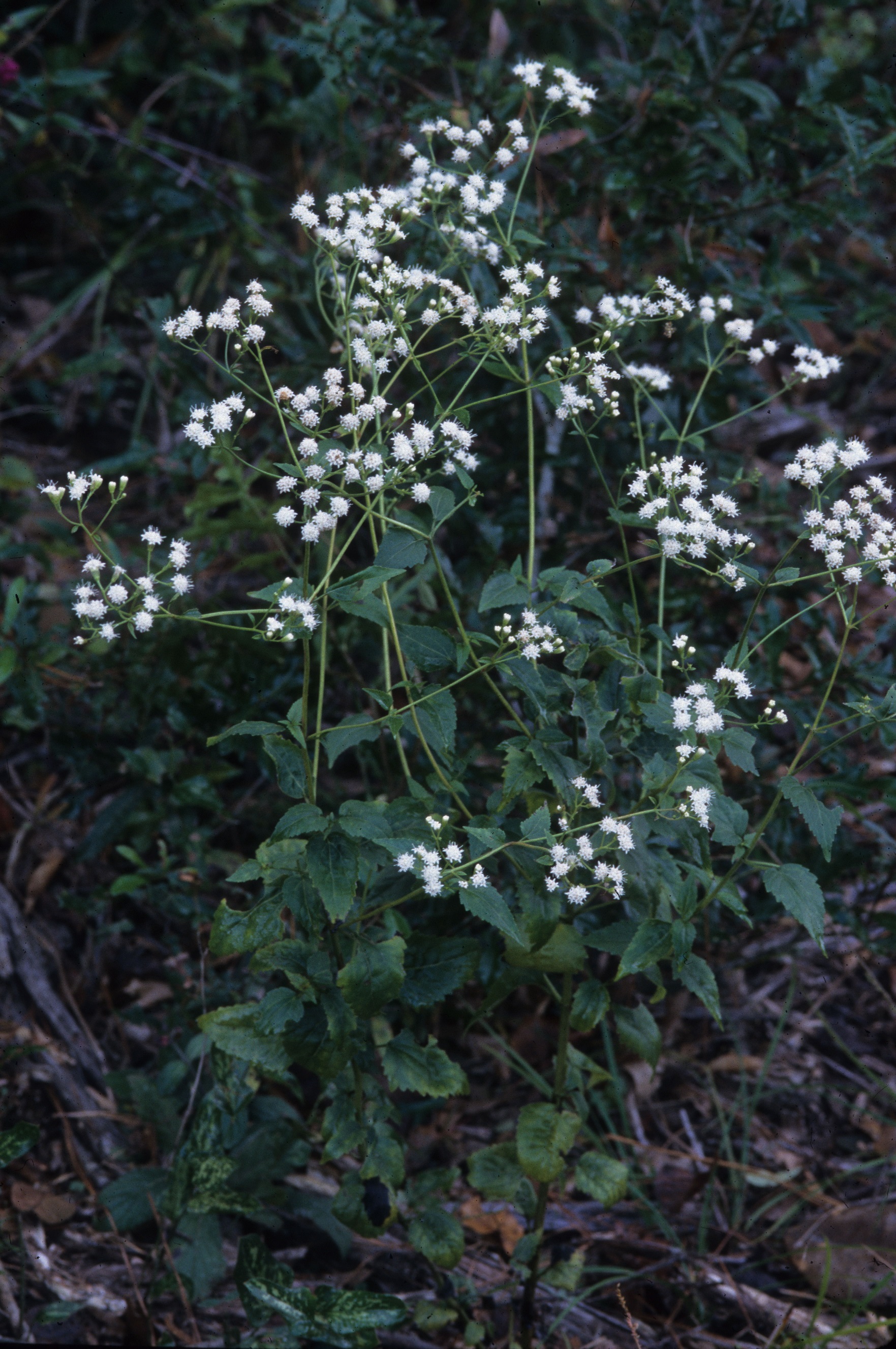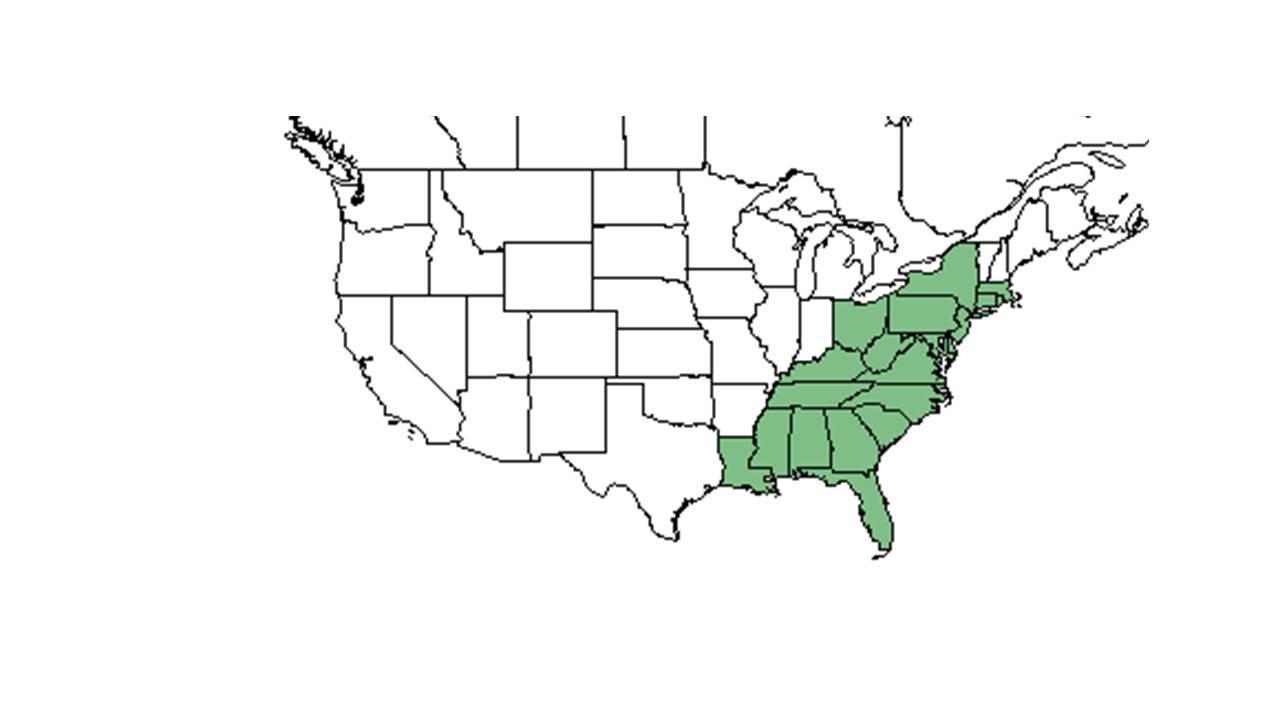Difference between revisions of "Ageratina aromatica"
Krobertson (talk | contribs) |
Lsandstrum (talk | contribs) |
||
| Line 37: | Line 37: | ||
===Habitat===<!--Natural communities, human disturbed habitats, topography, hydrology, soils, light, fire regime requirements for removal of competition, etc.--> | ===Habitat===<!--Natural communities, human disturbed habitats, topography, hydrology, soils, light, fire regime requirements for removal of competition, etc.--> | ||
Habitats of ''A. aromatica'' include longleaf pine-wiregrass flatwoods and open longleaf pine-scrub-oak-wiregrass savannas, mixed pine-hardwood forests, open oak woods, live oak woodlands, longleaf pine sand ridges, upland woodlands, and rolling red hills. It can also be found in disturbed habitat such as roadsides, along fences, and on the edges of fields.<ref name="fsu">.Florida State University Robert K. Godfrey Herbarium database. URL: http://herbarium.bio.fsu.edu. Last accessed: June 2014. Collectors: Loran C. Anderson, Robert Blaisdell, Andre F. Clewell, William B. Fox, J. P. Gillespie, Robert K. Godfrey, C. Jackson, Gary R. Knight, R. Komarek, Robert Kral, Robert L. Lazor, Sidney McDaniel, Richard S. Mitchell, P. L. Redfearn Jr., V. I. Sullivan, Jean W. Wooten, and Geo. Wilder MacClendons. States and Counties: Florida: Bay, Calhoun, Escambia, Franklin, Gadsden, Gulf, Holmes, Jackson, Jefferson, Leon, Levy, Liberty, Madison, Okaloosa, Putnam, Santa Rosa, St. Johns, and Wakulla. Georgia: Grady.</ref> ''A. aromatica'' is considered a dominant plant species in post-agricultural longleaf pine savannas.<ref name= "Ostertag">Ostertag, T. E. and K. M. Robertson (2007). A comparison of native versus old-field vegetation in upland pinelands managed with frequent fire, south Georgia, USA. Proceedings of the 23rd Tall Timbers Fire Ecology Conference: Fire in Grassland and Shrubland Ecosystems, Tallahassee, Tall Timbers Research Station. | Habitats of ''A. aromatica'' include longleaf pine-wiregrass flatwoods and open longleaf pine-scrub-oak-wiregrass savannas, mixed pine-hardwood forests, open oak woods, live oak woodlands, longleaf pine sand ridges, upland woodlands, and rolling red hills. It can also be found in disturbed habitat such as roadsides, along fences, and on the edges of fields.<ref name="fsu">.Florida State University Robert K. Godfrey Herbarium database. URL: http://herbarium.bio.fsu.edu. Last accessed: June 2014. Collectors: Loran C. Anderson, Robert Blaisdell, Andre F. Clewell, William B. Fox, J. P. Gillespie, Robert K. Godfrey, C. Jackson, Gary R. Knight, R. Komarek, Robert Kral, Robert L. Lazor, Sidney McDaniel, Richard S. Mitchell, P. L. Redfearn Jr., V. I. Sullivan, Jean W. Wooten, and Geo. Wilder MacClendons. States and Counties: Florida: Bay, Calhoun, Escambia, Franklin, Gadsden, Gulf, Holmes, Jackson, Jefferson, Leon, Levy, Liberty, Madison, Okaloosa, Putnam, Santa Rosa, St. Johns, and Wakulla. Georgia: Grady.</ref> ''A. aromatica'' is considered a dominant plant species in post-agricultural longleaf pine savannas.<ref name= "Ostertag">Ostertag, T. E. and K. M. Robertson (2007). A comparison of native versus old-field vegetation in upland pinelands managed with frequent fire, south Georgia, USA. Proceedings of the 23rd Tall Timbers Fire Ecology Conference: Fire in Grassland and Shrubland Ecosystems, Tallahassee, Tall Timbers Research Station. | ||
| − | </ref> This species is observed in a range of light conditions, from open forest situations to semi-shaded and shady areas. It occurs most frequently in moist sandy loam, dry sand, and areas of lime rock.<ref name= "fsu"/> | + | </ref> This species is observed in a range of light conditions, from open forest situations to semi-shaded and shady areas. It occurs most frequently in moist sandy loam, dry sand, and areas of lime rock.<ref name= "fsu"/> When exposed to soil disturbance by military training in West Georgia, ''A. aromatica'' responds negatively by way of absence.<ref>Dale, V.H., S.C. Beyeler, and B. Jackson. (2002). Understory vegetation indicators of anthropogenic disturbance in longleaf pine forests at Fort Benning, Georgia, USA. Ecological Indicators 1(3):155-170.</ref> |
Associated species: ''Andropogon, Chamaecrista fasiculata, Eupatorium album, Helianthus angustifolius, Liatris graminifolia, Solidago odora, Sorghastrum nutans, Quercus'' species, ''Pinus palutris, Aristida stricta, Quercus laevis, Pinus echinata, Liatris, Dicerandra,'' and others.<ref name="fsu"/> | Associated species: ''Andropogon, Chamaecrista fasiculata, Eupatorium album, Helianthus angustifolius, Liatris graminifolia, Solidago odora, Sorghastrum nutans, Quercus'' species, ''Pinus palutris, Aristida stricta, Quercus laevis, Pinus echinata, Liatris, Dicerandra,'' and others.<ref name="fsu"/> | ||
Revision as of 18:40, 11 July 2019
| Ageratina aromatica | |
|---|---|

| |
| Photo taken by Gil Nelson | |
| Scientific classification | |
| Kingdom: | Plantae |
| Division: | Magnoliophyta - Flowering plants |
| Class: | Magnoliopsida - Dicotyledons |
| Order: | Asterales |
| Family: | Asteraceae ⁄ Compositae |
| Genus: | Ageratina |
| Species: | A. aromatica |
| Binomial name | |
| Ageratina aromatica (L.) Spach | |

| |
| Natural range of Ageratina aromatica from USDA NRCS Plants Database. | |
Common names: Lesser snakeroot; Wild hoarhound; Small-leaved White Snakeroot
Contents
Taxonomic notes
Synonyms: Eupatorium aromaticum Linnaeus; Eupatorium aromaticum var. aromaticum; Eupatorium aromaticum var. incisum A. Gray; A. aromatica var. aromatica; A. aromatica var. incisa (Gray) C.F. Reed; Eupatorium latidens Small
The genus name Ageratina comes from the Greek word "agera" which means un-aging, not growing old in reference to the longevity of the flowers. The specific epithet comes from the Greek word "aroma" meaning spice seasoning.[1]
Description
A description of Ageratina aromatica is provided in The Flora of North America.
Ageratina aromatica is a perennial.[2] It can be distinguished from the closely related A. altissima by having smaller, thicker, and less sharply toothed leaves on shorter petioles, smaller stature, smaller flower heads, and thicker roots, and shorter, firmer pubescence.[3]
Distribution
It is infrequent in west Florida. It is found west to Mississippi, east towards Pennsylvania and Massachusetts.[2] It is regionally rare in New England. In Massachusetts and Connecticut it is listed as endangered (S1) and in Rhode Island is historical only (SH).[3]
Ecology
Habitat
Habitats of A. aromatica include longleaf pine-wiregrass flatwoods and open longleaf pine-scrub-oak-wiregrass savannas, mixed pine-hardwood forests, open oak woods, live oak woodlands, longleaf pine sand ridges, upland woodlands, and rolling red hills. It can also be found in disturbed habitat such as roadsides, along fences, and on the edges of fields.[4] A. aromatica is considered a dominant plant species in post-agricultural longleaf pine savannas.[5] This species is observed in a range of light conditions, from open forest situations to semi-shaded and shady areas. It occurs most frequently in moist sandy loam, dry sand, and areas of lime rock.[4] When exposed to soil disturbance by military training in West Georgia, A. aromatica responds negatively by way of absence.[6]
Associated species: Andropogon, Chamaecrista fasiculata, Eupatorium album, Helianthus angustifolius, Liatris graminifolia, Solidago odora, Sorghastrum nutans, Quercus species, Pinus palutris, Aristida stricta, Quercus laevis, Pinus echinata, Liatris, Dicerandra, and others.[4]
Phenology
It can spread vegetatively in a limited area, but it is dependent on sexual reproduction to colonize new areas.[3] Flowering occurs in the fall[7], and has been observed flowering in the months of October, November, and January with peak inflorescence in October. [8] It has been observed fruiting in October and November as well.[4]
In north Florida, it has been observe to reproduce with A. juncunda suggesting these species are possibly conspecific.[9]
Seed dispersal
This species is thought to be dispersed by wind. [10]
Fire ecology
Ageratina aromatica is found in annually burned savannas and wet pinelands.[4] It is the common ground cover species of North Florida Longleaf Woodlands, which are dependent on fire.[11] This species requires full to partial sun, therefore forest maturation and canopy closure resulting from a lack of disturbance such as fire can shade out A. aromatica.[3]
Conservation and management
In New England, it is threatened by fire suppression and lack of disturbance that allows for canopy closure and forest maturation, resulting in lack of sunlight needed for A. aromatica to prosper.[3] It is listed as endangered in the state of Massachusetts. [12]
Cultivation and restoration
Photo Gallery
References and notes
- ↑ [[1]]Alabama Plants. Accessed: March 22, 2016
- ↑ 2.0 2.1 Hall, David W. Illustrated Plants of Florida and the Coastal Plain: based on the collections of Leland and Lucy Baltzell. 1993. A Maupin House Book. Gainesville. 100. Print.
- ↑ 3.0 3.1 3.2 3.3 3.4 [[2]]New England Wild. Accessed: March 22, 2016
- ↑ 4.0 4.1 4.2 4.3 4.4 .Florida State University Robert K. Godfrey Herbarium database. URL: http://herbarium.bio.fsu.edu. Last accessed: June 2014. Collectors: Loran C. Anderson, Robert Blaisdell, Andre F. Clewell, William B. Fox, J. P. Gillespie, Robert K. Godfrey, C. Jackson, Gary R. Knight, R. Komarek, Robert Kral, Robert L. Lazor, Sidney McDaniel, Richard S. Mitchell, P. L. Redfearn Jr., V. I. Sullivan, Jean W. Wooten, and Geo. Wilder MacClendons. States and Counties: Florida: Bay, Calhoun, Escambia, Franklin, Gadsden, Gulf, Holmes, Jackson, Jefferson, Leon, Levy, Liberty, Madison, Okaloosa, Putnam, Santa Rosa, St. Johns, and Wakulla. Georgia: Grady.
- ↑ Ostertag, T. E. and K. M. Robertson (2007). A comparison of native versus old-field vegetation in upland pinelands managed with frequent fire, south Georgia, USA. Proceedings of the 23rd Tall Timbers Fire Ecology Conference: Fire in Grassland and Shrubland Ecosystems, Tallahassee, Tall Timbers Research Station.
- ↑ Dale, V.H., S.C. Beyeler, and B. Jackson. (2002). Understory vegetation indicators of anthropogenic disturbance in longleaf pine forests at Fort Benning, Georgia, USA. Ecological Indicators 1(3):155-170.
- ↑ Wunderlin, Richard P. and Bruce F. Hansen. Guide to the Vascular Plants of Florida. Second edition. 2003. University Press of Florida: Gainesville/Tallahassee/Tampa/Boca Raton/Pensacola/Orlando/Miami/Jacksonville/Ft. Myers. 295. Print.
- ↑ Nelson, G. PanFlora: Plant data for the eastern United States with emphasis on the Southeastern Coastal Plains, Florida, and the Florida Panhandle. www.gilnelson.com/PanFlora/ Accessed: 4 MAR 2019
- ↑ Clewell, A. F. and J. W. Wooten (1971). "A Revision of Ageratina (Compositae: Eupatorieae) from Eastern North America." Brittonia 23(2): 123-143.
- ↑ Kirkman, L. Katherine. Unpublished database of seed dispersal mode of plants found in Coastal Plain longleaf pine-grasslands of the Jones Ecological Research Center, Georgia.
- ↑ Carr, S. C., K. M. Robertson, et al. (2010). "A Vegetation Classification of Fire-Dependent Pinelands of Florida." Castanea 75(2): 153-189.
- ↑ USDA Plants Database URL: https://plants.usda.gov/core/profile?symbol=ANGE